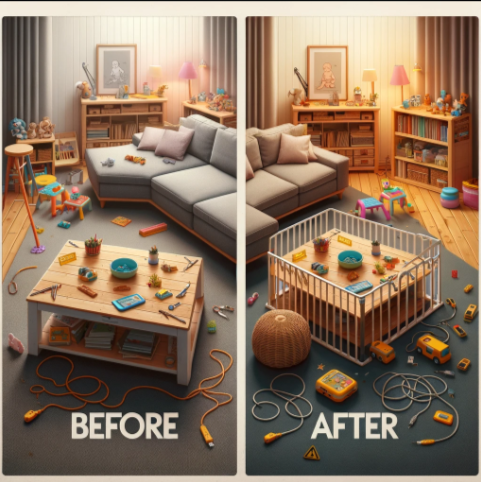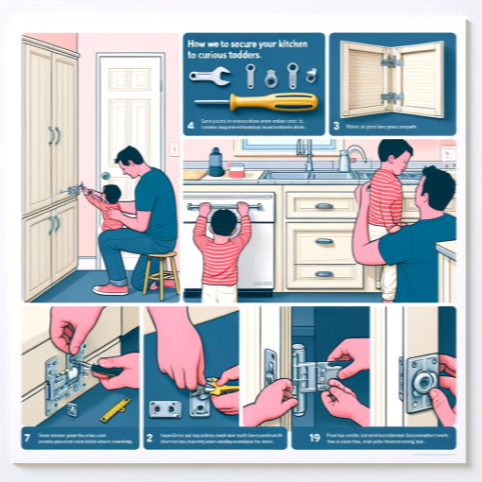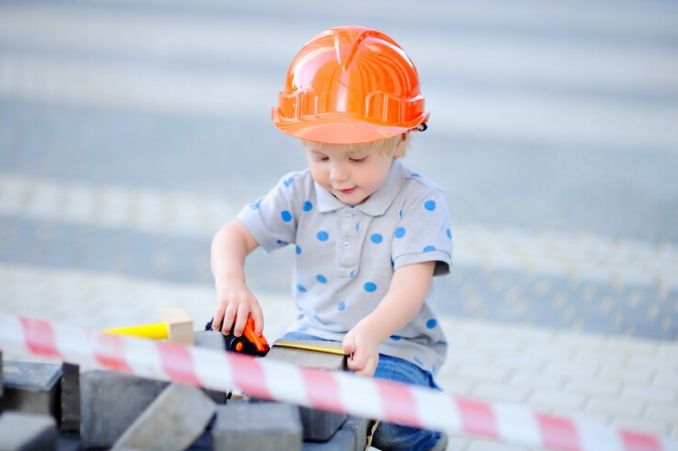With this comprehensive guide on childproofing, you may discover the keys to a safer house for your children. Learn professional advice on how to keep your family safe.
Introduction to Childproofing
Every parent and caregiver should conduct the crucial process of childproofing to guarantee the security and welfare of children, especially young children and newborns. These youthful adventurers are motivated by an inborn curiosity and a lack of knowledge about the possible threats in their immediate environment. They pick up knowledge through tasting, feeling, and moving around—all of which might put them in danger even though these senses are vital to their development. This is where childproofing enters the picture. It’s a proactive way to redefine your home as a place of growth and adventure rather than danger lurking around every corner.
Since the house is the place where children spend a large portion of their time, childproofing aims to reduce the likelihood of mishaps and injuries. Common household items and structures that adults frequently ignore can seriously harm young children. Unsecured furniture has the potential to topple over; readily accessible cabinets may hold dangerous substances; and exposed electrical outlets may draw inquisitive hands. By adding extra levels of safety, childproofing aims to solve these problems as well as others, enabling kids to explore without fear.
Important Points
During the procedure, every room is carefully inspected from a child’s point of view. It calls on parents to kneel at their child’s level and search for potential hazards such as jagged edges, small objects that could strangle a youngster, and easily accessible, dangerous places. All areas that the child can access, such as living rooms, kitchens, bathrooms, and even outdoor spaces, should be taken into account. Safety devices, which serve to block or cushion possible threats, such as cabinet locks, corner protectors, safety gates, and window guards, become indispensable instruments in the childproofing arsenal.

However, childproofing entails more than just setting up safety equipment—it also entails making a space that is safer and fosters the growth of the child. Children should be able to explore their curiosity and gain knowledge about the world around them in this setting without having to take unwarranted risks. For instance, parents may decide to designate particular child-safe zones where exploration is encouraged and where safe objects are available for touch and interaction, as opposed to just locking away every object. This helps the youngster develop their motor and cognitive skills, in addition to keeping them safe.
Childproofing Requires Constant Effort
Furthermore, childproofing requires constant effort. What was previously a safe atmosphere may now pose new difficulties as kids mature and gain new skills. For example, toddlers may learn how to unlock locks or get over barriers. Parents must be watchful and constantly evaluate their homes to adjust their childproofing tactics. This might be changing locks, making newly accessible locations secure, or even giving youngsters safety and boundary education.
Even though childproofing requires physical measures, education and supervision are equally important. Childproofing is not a substitute for a caregiver’s close supervision. Childproofing can also become an educational experience as youngsters learn basic safety principles, transforming a series of barriers. This keeps them safe within the house and starts to get them ready for life outside the house.
The first step in providing a secure and caring environment for kids is childproofing. It demands a proactive and continuing strategy, mixing physical safety measures with teaching and supervision. Parents who make the effort to properly childproof their space can give their children a safe environment in which they can develop, learn, and explore without having to take unnecessary risks. By doing this, childproofing transcends from a safety precaution to a fundamental part of raising a contented, healthy, and inquisitive child.
Recognizing the Value of Childproofing
Every parent and caregiver should conduct the crucial process of childproofing to guarantee the security and welfare of children, especially young children and newborns. These youthful adventurers are motivated by an inborn curiosity and a lack of knowledge about the possible threats in their immediate environment. They pick up knowledge through tasting, feeling, and moving around—all of which might put them in danger even though these senses are vital to their development. This is where childproofing enters the picture. It’s a proactive way to redefine your home as a place of growth and adventure rather than danger lurking around every corner.
Since the house is the place where children spend a large portion of their time, childproofing aims to reduce the likelihood of mishaps and injuries. Common household items and structures that adults frequently ignore can seriously harm young children. Unsecured furniture has the potential to topple over; readily accessible cabinets may hold dangerous substances; and exposed electrical outlets may draw inquisitive hands. By adding extra levels of safety, childproofing aims to solve these problems as well as others, enabling kids to explore without fear.
During the procedure, every room is carefully inspected from a child’s point of view. It calls on parents to kneel at their child’s level and search for potential hazards such as jagged edges, small objects that could strangle a youngster, and easily accessible, dangerous places. All areas that the child can access, such as living rooms, kitchens, bathrooms, and even outdoor spaces, should be taken into account. Safety devices, which serve to block or cushion possible threats, such as cabinet locks, corner protectors, safety gates, and window guards, become indispensable instruments in the childproofing arsenal.
Safety Equipments and Childproofing
However, childproofing entails more than just setting up safety equipment—it also entails making a space that is safer and fosters the growth of the child. Children should be able to explore their curiosity and gain knowledge about the world around them in this setting without having to take unwarranted risks. For instance, parents may decide to designate particular child-safe zones where exploration is encouraged and where safe objects are available for touch and interaction, as opposed to just locking away every object. This helps the youngster develop their motor and cognitive skills, in addition to keeping them safe.
Furthermore, childproofing requires constant effort. What was previously a safe atmosphere may now pose new difficulties as kids mature and gain new skills. For example, toddlers may learn how to unlock locks or get over barriers. Parents must be watchful and constantly evaluate their homes to adjust their childproofing tactics. This might be changing locks, making newly accessible locations secure, or even giving youngsters safety and boundary education.
Even though childproofing requires physical measures, education and supervision are equally important. Childproofing is not a substitute for a caregiver’s close supervision. Childproofing can also become an educational experience as youngsters learn basic safety principles, transforming a series of barriers. This serves to safeguard them both within the house and to start preparing them for life outside of it.
Childproofing for Various Stages of Childhood Infants: The Early Explorers
Make sure the floor is a safe place for your baby to explore when they begin to crawl. Eliminate small items that may provide a choking hazard, fasten loose carpets to avoid trips and falls, and use safety gates to divide off stairs and hazardous areas.
Toddlers: The Risk-Taking Athletes

Accidents involving furniture and TVs tipping over become a serious issue as kids start to walk and climb. Make sure that TVs are mounted or positioned far back on solid stands, and fasten heavy furniture to the walls using anchors. Also, take down anything that can be climbed close to windows and balconies.
Young Children: The Curious Explorers
Children are inquisitive at this age and may be able to reach higher areas or open basic locks. Increase the security of your products by locking cupboards and doors and keeping dangerous items out of reach or in locked storage.
Area-Specific Methods for Childproofing
The Culinary Danger Zone is the Kitchen
There are several possible risks in kitchens. In addition to locking drawers and cabinets, think about locking appliances, covering stove knobs, and putting breakables and knives out of reach. Additionally, wherever possible, utilize rear burners and never leave cooking alone.
Living Room: The Main Entrance
This well-used area needs to be free of tiny, ingestible objects, have furniture and bookcases that are fastened, and have soft padding around any sharp edges. Make sure all outlets are covered and cords are tucked away.
The Wet and Slippery Spot: The Bathroom
Install toilet locks to prevent drowning, use non-slip mats when entering and exiting the tub, and store all cleaning and medication supplies in high, locked cabinets. Take into account a faucet cover as well to avoid burns and other harm.
Outside Areas: The Unspoiled outdoors
Make sure play equipment is sturdy and in good working order; secure pools with fences and gates; and store dangerous tools and chemicals away. Regardless of how well you’ve childproofed, you should always keep an eye on kids outside.
Advanced Childproofing Measures Technology Aids:
Take into consideration smart cabinet and door alarms and locks that can notify you when something is accessed. Furthermore, Wi-Fi cameras are useful for keeping an eye out for possible threats in your home’s rooms.
Being Ready for Emergencies:
Teach your child basic safety information, like their full name, address, and how to dial emergency numbers. Have a list of emergency contacts and medical information conveniently accessible.
Services for childproofing:
Professional childproofing services can install the required devices and conduct a thorough home safety evaluation if the task seems too big for you.
Keeping Your Home Childproof
Frequent inspections and updates:
Your child’s skills and interests will evolve as they get older. Continually reevaluate your house for potential threats and adjust your childproofing strategies as necessary.
Education and supervision: Although taking physical precautions is essential, it’s also critical to teach your child about safety as they grow older. To help kids comprehend the risks and how to avoid them, combine education with close supervision.
Finding a Balance between Safety and Exploration: Keeping your kids safe should come first, but you also need to give them the chance to explore and learn. Aim for a balance that will safely and responsibly pique their curiosity.
Childproofing is a necessary, continuous process that changes as your child does. You can establish a safe environment where they can explore and learn without taking unnecessary risks if you remain vigilant and knowledgeable.
An in-depth Manual for Childproofing your House
Secure Cabinets and Drawers:
For the safety of your kitchen and bathroom, lock any cabinets and drawers that a young child or toddler could open. This stops dangerous materials and sharp things from being accessible.
Control the heat and alerts.
Avoid scaling: To avoid burns, set your water heater to 120 degrees Fahrenheit.
Install smoke and carbon monoxide detectors on each floor of your house and close to any bedrooms to help you stay safe.
Outlet and Furniture Safety:
Cushion Sharp Corners: Place cushions on the corners of furniture to prevent injuries from falls.
Outlet Covers: Secure all electrical outlets with covers to prevent electrical accidents.
Sleep Safety: A Safe Sleeping Environment Ensure your baby sleeps on a firm, flat surface on their back and alone, with no added items in the sleeping area.
Window Coverings: Prevent Strangulation: Use cordless window coverings in households with small children to help prevent mishaps.
Bathroom Hazards:
Preventing Drowning: Recognize that a youngster may drown in as little as one or two inches of water. Never leave your youngster unattended in the restroom, and consider utilizing door locks to prevent unsupervised access.
Conclusion
Childproofing is a continual process that changes as your child develops and explores. By taking proactive precautions and regularly analyzing your house for potential hazards, you can create a safer atmosphere that fosters your child’s development and peace of mind.






